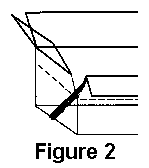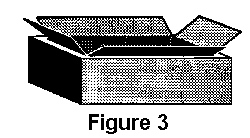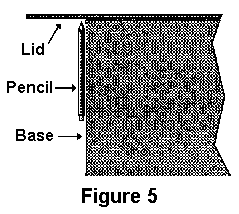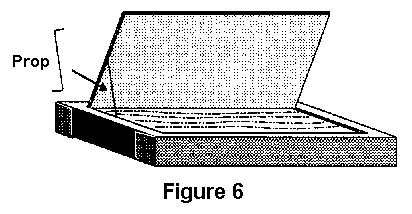| A
great solar oven you can build quickly from two cardboard boxes |
 Experiments
in Seattle and Arizona have proven that solar box cookers can be built more
simply than even the simple method we have been using. These discoveries have
paved the way for a simpler construction method that allows a cooker to be
built in a few hours for very little money. Experiments
in Seattle and Arizona have proven that solar box cookers can be built more
simply than even the simple method we have been using. These discoveries have
paved the way for a simpler construction method that allows a cooker to be
built in a few hours for very little money. |
The
following developments make this design possible:
- Insulation
material is not essential in the walls -- a foiled airspace is all that is
necessary.
- Aluminum
foil can be reduced to just one layer (though a layer on the inside of each
box makes a hotter oven).
- The
airspace between the walls can be very small.
- Almost
any size oven will cook. In general, larger ovens get hotter and can cook more
food, but the limiting factor is still the ratio between the mass of the food
and the size of the oven. In general it is best to make an oven as large as
is conveniently possible so that it will perform adequately even under marginal
conditions.
- Our
experience shows that a double layer of plastic film (such as Reynolds Oven
Cooking Bags�) works at least as well as a single sheet of glass.
- Shallower
ovens cook better since they have less wall area through which to lose heat.
It's best for the inside of the oven to be just slightly taller than the biggest
pot you plan to use.
A
New Simpler DesignTaking
these factors into account, we are able to take our best shot at describing
the minimum solar box cooker -- one that can be built by anyone with access
to cardboard, foil, glue, and plastic or glass. What
You Will Need
- Two
cardboard boxes. We would suggest that you use an inner box that is at least
15" x 15" (38cm x 38cm), but bigger is better. The outer box should be larger
all around, but it doesn't matter how much bigger, as long as there is a half
inch (1.5cm) or more of an airspace between the two boxes. Also note that the
distance between the two boxes does not have to be equal all the way around.
Also, keep in mind that it is very easy to adjust the size of a cardboard box
by cutting and gluing it.
- One
sheet of cardboard to make the lid. This piece must be approximately 2" - 3"
(4 - 8cm) larger all the way around than the top of the finished cooker.
- One
small roll of aluminum foil.
- One
can of flat-black spray paint (says on can "non-toxic when dry") or one small
jar of black tempera paint. Some people have reported making their own paint
out of soot mixed with wheat paste.
- At
least 8 ounces of white glue or wheat paste.
- One
Reynolds Oven Cooking Bag�. These are available in almost all supermarkets
in the U.S. and they can be mail-ordered from Solar Cookers International.
They are rated for 400� F (204.4� C) so they are perfect for solar cooking.
They are not UV-resistant; thus they will become more brittle and opaque over
time and may need to be replaced periodically. A sheet of glass can also be
used, but this is more expensive and fragile, and doesn't offer that much better
cooking except on windy days.

Building
the BaseFold
the top flaps closed on the outer box and set the inner box on top and trace
a line around it onto the top of the outer box, Remove the inner box and cut
along this line to form a hole in the top of the outer box (Figure 1). 
Decide
how deep you want your oven to be (about 1" or 2.5cm bigger than your largest
pot and at least 1" shorter than the outer box) and slit the corners of the
inner box with a knife down to that height. Fold each side down forming extended
flaps (Figure 2). Folding is smoother if you first draw a firm line from the
end of one cut to the other where the folds are to go. Glue
aluminum foil to the inside of both boxes and also to the inside of the remaining
top flaps of the outer box. Don't waste your time being neat on the outer box,
since it will never be seen, nor will it experience any wear. The inner box
will be visible even after assembly, so if it matters to you, you might want
to take more time here. Glue the top flaps closed on the outer box.  Place
some wads of crumpled newspaper into the outer box so that when you set the
inner box down inside the hole in the outer box, the flaps on the inner box
just touch the top of the outer box (Figure 3). Glue these flaps onto the top
of the outer box. Trim the excess flap length to be even with the perimeter
of the outer box. Place
some wads of crumpled newspaper into the outer box so that when you set the
inner box down inside the hole in the outer box, the flaps on the inner box
just touch the top of the outer box (Figure 3). Glue these flaps onto the top
of the outer box. Trim the excess flap length to be even with the perimeter
of the outer box.
Finally,
to make the drip pan, cut a piece of cardboard, the same size as the bottom
of the interior of the oven and apply foil to one side. Paint this foiled side
black and allow it to dry. Put this in the oven (black side up) and place your
pots on it when cooking. The base is now finished.
Building
the Removable Lid Take
the large sheet of cardboard and lay it on top of the base. Trace its outline
and then cut and fold down the edges to form a lip of about 3" (7.5cm). Fold
the corner flaps around and glue to the side lid flaps. (Figure 4). Orient
the corrugations so that they go from left to right as you face the oven so
that later the prop may be inserted into the corrugations (Figure 6). One trick
you can use to make the lid fit well is to lay the pencil or pen against the
side of the box when marking (Figure 5). Don't glue this lid to the box; you'll
need to remove it to move pots in and out of the oven. Take
the large sheet of cardboard and lay it on top of the base. Trace its outline
and then cut and fold down the edges to form a lip of about 3" (7.5cm). Fold
the corner flaps around and glue to the side lid flaps. (Figure 4). Orient
the corrugations so that they go from left to right as you face the oven so
that later the prop may be inserted into the corrugations (Figure 6). One trick
you can use to make the lid fit well is to lay the pencil or pen against the
side of the box when marking (Figure 5). Don't glue this lid to the box; you'll
need to remove it to move pots in and out of the oven.
 To
make the reflector flap, draw a line on the lid, forming a rectangle the same
size as the oven opening. Cut around three sides and fold the resulting flap
up forming the reflector (Figure 6). Foil this flap on the inside. To
make the reflector flap, draw a line on the lid, forming a rectangle the same
size as the oven opening. Cut around three sides and fold the resulting flap
up forming the reflector (Figure 6). Foil this flap on the inside.
To
make a prop bend a 12" (30cm) piece of hanger wire as indicated in Figure 6.
This can then be inserted into the corrugations as shown. Next,
turn the lid upside-down and glue the oven bag (or other glazing material)
in place. We have had great success using the turkey size oven bag (19" x 23
1/2", 47.5cm x 58.5cm) applied as is, i.e., without opening it up. This makes
a double layer of plastic. The two layers tend to separate from each other
to form an airspace as the oven cooks. When using this method, it is important
to also glue the bag closed on its open end. This stops water vapor from entering
the bag and condensing. Alternately you can cut any size oven bag open to form
a flat sheet large enough to cover the oven opening.  Improving
Efficiency Improving
Efficiency
The
oven you have built should cook fine during most of the solar season. If you
would like to improve the efficiency to be able to cook on more marginal days,
you can modify your oven in any or all of the following ways: - Make
pieces of foiled cardboard the same size as the oven sides and place these
in the wall spaces.
- Make
a new reflector the size of the entire lid (see photo).
- Make
the drip pan using sheet metal, such as aluminum flashing. Paint this black
and elevate this off the bottom of the oven slightly with small cardboard strips.
| 
